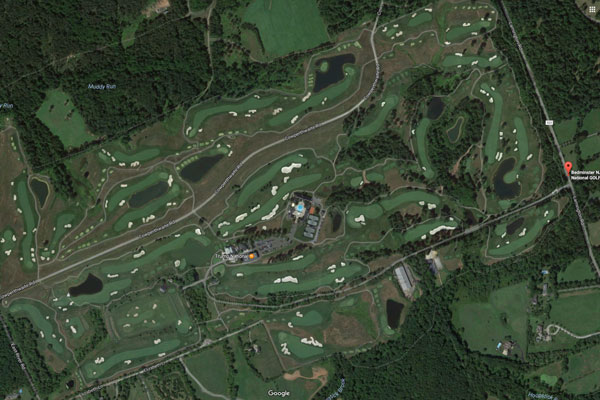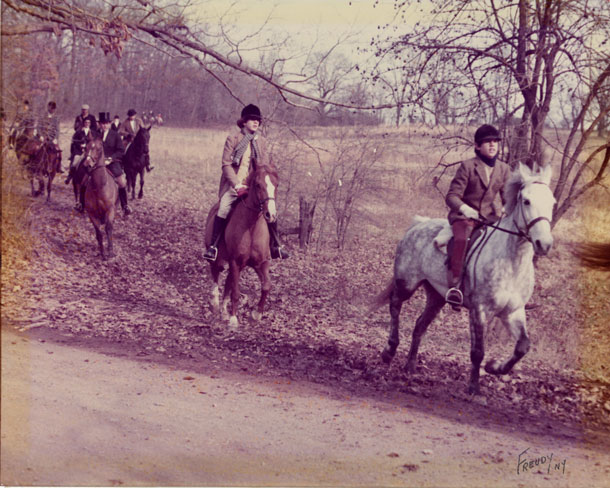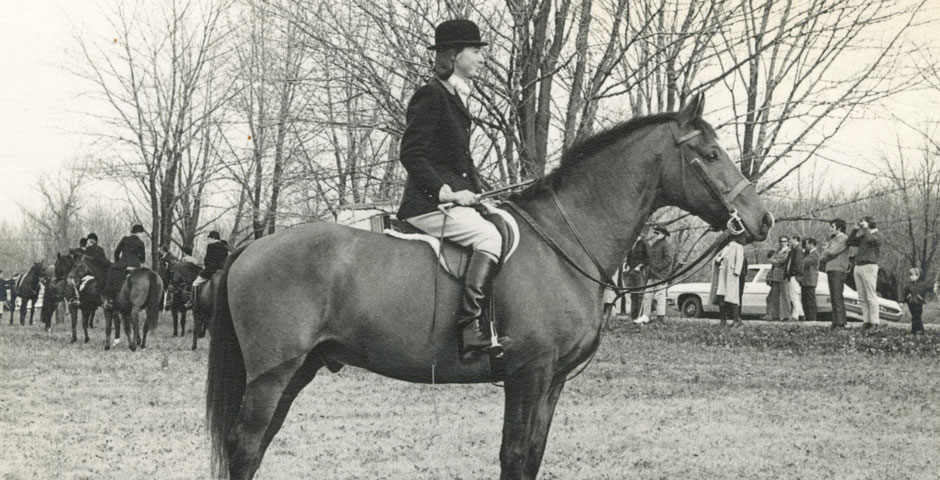Judy Richter grew up riding on what is now the TRUMP NATIONAL GOLF CLUB, and she has offered to share her memories.
The Trump National Golf Club, also known as the Trump Summer White House, is in Bedminster Township, New Jersey. Here, “You are just as likely to see a horse coming down the road as a Range Rover,” Steven Parker, the mayor of Bedminster, told The New York Times recently.
The Trump National, 49 miles from Trump Tower in New York City, was once Lamington Farm, owned by Morgan Cowperthwaite, an executive at a New York insurance firm. In 1981 the estate was sold to automaker John Z. DeLorean. Shortly after the sale, DeLorean was charged with conspiring to sell cocaine to fund his DeLorean Motor Company, and the estate was sold again. After other owners, Mr. Trump purchased it in 2002 for an estimated $35 million and reportedly has since invested $45 million
in the property.

Published November 2017. The TV news was showing our president retreating to his estate in Bedminster, New Jersey, and it unleashed a host of memories for me. I grew up just down the road and knew the property well, having ridden up and down all those rolling hills when I was growing up. Marooned on a farm far from everywhere, my sister Carol and I relied on our only transport, our horses, and we did get around quite nicely.
Those 400 acres were known in the 1950s as the Cowperthwaite place. Mrs. Cowperthwaite was a Brady, as in James Cox Brady, the financier, so there was plenty of money, old money. They were an elegant family and shared their magnificent estate with the locals, which included us.
Today, it is no doubt enclosed by a high fence, a 21st-century feature to keep the riff-raff out—local yokels and gentry alike.
Many winter afternoons we’d dash home from school, saddle up, and trot briskly down the road in hopes of beating the late afternoon deepening dusk. Cowperthwaite’s was the best place to ride on those darkening evenings because their fields, crisscrossed by post-and-rail fencing, were studded with white chicken-coop jumps set in the fence lines for our safety and convenience.

Living in the country, we were surrounded by open space and farms enclosed by inviting split-rail fences that we enjoyed jumping year-round, except on dark winter afternoons. Then we headed toward Cowperthwaite’s, where you could actually see the white coops well enough, even if it was as dark as the inside of a cow. A chicken coop is a triangular, board fence about 12 feet long and three-and-a-half-feet high, enough to keep the cattle in and enticing for horses to jump over, even in the dark.
At the crossroads of Hickory Corner Road and Burnt Mill Road, we could either pop in over the white coop or gallop full tilt up the long hill toward Rattlesnake Bridge Road. Usually we opted for the latter, more for the thrill of the wind and the setting sun in our faces than for the glorious view at the top of the hill, where open space spread out before us. That chicken coop off the road at the top of the hill was a double, 24-feet instead of 12, so we could jump it in pairs, i.e., side by side.
“Left around or right around?”
“Left.”
Usually we went left, down and across the gully to acres of wide fields that extended as far as the eye could see.
When it was time to head back, we swung right behind the brick mansion and the various rustic red outbuildings where the Cowperthwaite’s horses and cattle were housed.
The lights were already on in the big house as we rode by the tall-columned front door. Having been invited to countless hunt breakfasts and receptions after the annual hunter trials, we knew that door opened to a spacious hall and winding staircase. To the left was the dining room, candlelight glowing and the table groaning from the weight of the food after the hunt, piled high for starving, cold riders who warmed themselves by the crackling fire as they waited in line to load their plates.
Starving and cold ourselves, we took up a spanking trot down the long winding driveway toward home. The memory of our tin-canning around Cowperthwaite’s open field and jumping back and forth over dozens of white chicken coops kept us warm enough until we reached our own barn door.
The Cowperthwaite children were our classmates and friends in school, so occasionally there were sleepovers with them. Because we lived in the country miles from one another, we usually stayed a day or so, not just a few hours.
When visiting the children, we used the side door to the kitchen—old-fashioned, even in those days. Since there was more than ample staff, Mrs. Cowperthwaite never cooked, so there was no reason to update the kitchen. Anyway, that was my mother’s explanation when we reported on the archaic appliances. It was proof that these people were neither extravagant nor interested in keeping up with the Joneses. They were the Joneses.
We kids spent most of our time in the kitchen or the cozy den nearby. Usually a warm fire was a welcome change from the vast dark halls and rooms beyond. Upstairs there were lots of bedrooms to choose from when it was time to go to bed after dinner in the kitchen.
We often hung out in the kitchen with the staff, who were always dressed in starched uniforms, even when the parents weren’t home. They often saved us a bowl of generously unscraped cookie or cake dough. We liked to play heatedly competitive games of jacks on the polished wood floor in front of the fire in the den. With no television, computers, or parents around, we were pretty much on our own.
One rainy afternoon we explored Mrs. Cowperthwaite’s shoe closet. Imagine. She had a walk-in closet just for shoes! And it had a light in it. There were rows and rows of shoes, every kind you could possibly dream of, from sneakers to saddle shoes to high heels of all different heights. I found the closet itself astounding, since I was growing up in an eighteenth-century house that featured very few closets, and those few were very shallow with no need for a light. We whiled away several hours trying on the shoes and then carefully put them back. Luckily, we just finished and were lurking in the dark hall when the lady of the house ascended the stairs. We fled and were not discovered.fox hunting, the hounds were running, our blood was up, and we were galloping full tilt up the Cowperthwaite driveway. Suddenly I heard a scream, and my sister’s pony, Little Arnold, galloped past me with Carol hanging from one stirrup, her head banging on the ground. Fortunately, her safety stirrup finally released her foot, and she was saved from being dragged to her death. She was fine. We caught her pony, snapped her stirrup back on, tossed her up, and galloped even faster to catch up. We had dodged a big bullet, but we scarcely gave it a thought at the time.

We didn’t even appreciate then that her pony turned back to us, probably looking more for his friends than his missing rider. He could have as easily run home without her. Little Arnold turned out to be more than what we all thought. A school pony useful in her summer camp, he was loaned to us every winter by June Wildes, a dear friend and neighbor in Vermont and our mentor as we were growing up. With Carol in the saddle, Little Arnold, who was an elderly snow-white, medium pony just under 13.2 hands, found out he could jump any fence in the hunt country and keep up with the field when hounds were running.
Getting back on your horse, no matter what, is not the only life lesson I learned at the Cowperthwaites’. Our Essex Fox Hounds Hunter Trials were held annually on their estate, about a mile and a half of galloping and jumping a prescribed course of rails and coops. There were various classes for children, ladies, amateurs, and open to all. Several judges, stationed around, gathered after every class to decide the winners as each of them judged different jumps for performance, manners, way of going, and style of jumping.
A habit early ingrained by our neighbor, friend, and icon, Arthur McCashin, first captain of our civilian show-jumping team, was to BE READY when you plan to compete. If you’re not ready, stay home and get ready for the next time, whenever it is. This tenet has stood me in good stead for my entire life, and we first learned its value as we prepared for the hunter trials. Arthur insisted that we ride over and school at least once the week before the event. Schooling on course was allowed since the jumps were there anyway. The “year of the ditch” was the one when we became true believers in the be-ready maxim. A big yawning ditch, part of the gully that ran through the property, was included in the course once, and never again. Arthur himself was there for the schooling over the ditch, heavily armed with a long longe whip. The mere sight of the whip upped our determination even more than our horses’. We knew if a rider stopped, the whip would wrap around both the horses’ rear end and the rider’s legs. The horses frogged it the first few times. So we jumped it over and over until they cruised smoothly across. That was Tuesday, and Arthur had us back Thursday to make sure everyone remembered how to jump the ditch. We did, and on the appointed day each of us sailed over the ditch, and one of us won every class we entered. If the other horses jumped the ditch at all, they frogged it. We were ready, and besides the cherished memories, we learned a couple of life lessons: when you fall off get back up, and be ready, so you probably won’t fall off.
There were four of us, Arthur’s sons Johnny and Freddy, Carol, and me. The McCashin boys were about our age, so we clung to their coattails, and besides learning life lessons, we learned how to ride. What better teachers in all of New Jersey—a state not famous for its trainers like those across the Hudson River— Gordon Wright and Al Holmwood, to name two.
Other than that one awful moment, all of my memories of that extraordinary estate are happy: our evening rides, larking in the darkness over the white coops, showing in the hunter trials, our sleepovers and adventures exploring the house, and the sumptuous hunt breakfasts, jolly and convivial. Some of the men were in their pink coats, actually scarlet but named for the famous tailor, Mr. Pink in London. The pink coat is awarded to the knowledgeable fox hunter, who knows hounds, hound work, and the countryside, and hence is a good person to follow if you are a newcomer to the field, as the the group of riders is known. However, every year the newbies revealed themselves at the first hunt breakfast, where it was more proper to wear a tweed coat.
At the annual hunt ball, also held in the Cowperthwaites’ ballroom and adjoining rooms, the real foxhunters turned out in the pink tails and the women properly wore either black or white gowns, except for the newbies who were clothed in every color of the rainbow. It all sounds very stuffy, but it is tradition even today. For us children, our 18th birthday was the watershed, and our first hunt ball was exciting.
These days, the fox hunters and the chicken coops are gone from Cowperthwaite’s estate; now it’s a state-of-the-art golf course, and the main house is the club house. As I watched TV, more interesting to me than watching the people was peeking around them, trying to get a glimpse of that stately mansion and all its memories.
JUDY RICHTER has been in the horse business for over 55 years. She has written numerous books (See Equestrian Living June 2016) and has trained national and international champions as well as USET and Maclay finals winners. Richter says, “Over the years I’ve been blessed with good horses and good riders, many highly motivated to be better. Most exciting of all to me is to watch some of my students excel as riders and trainers today.”

